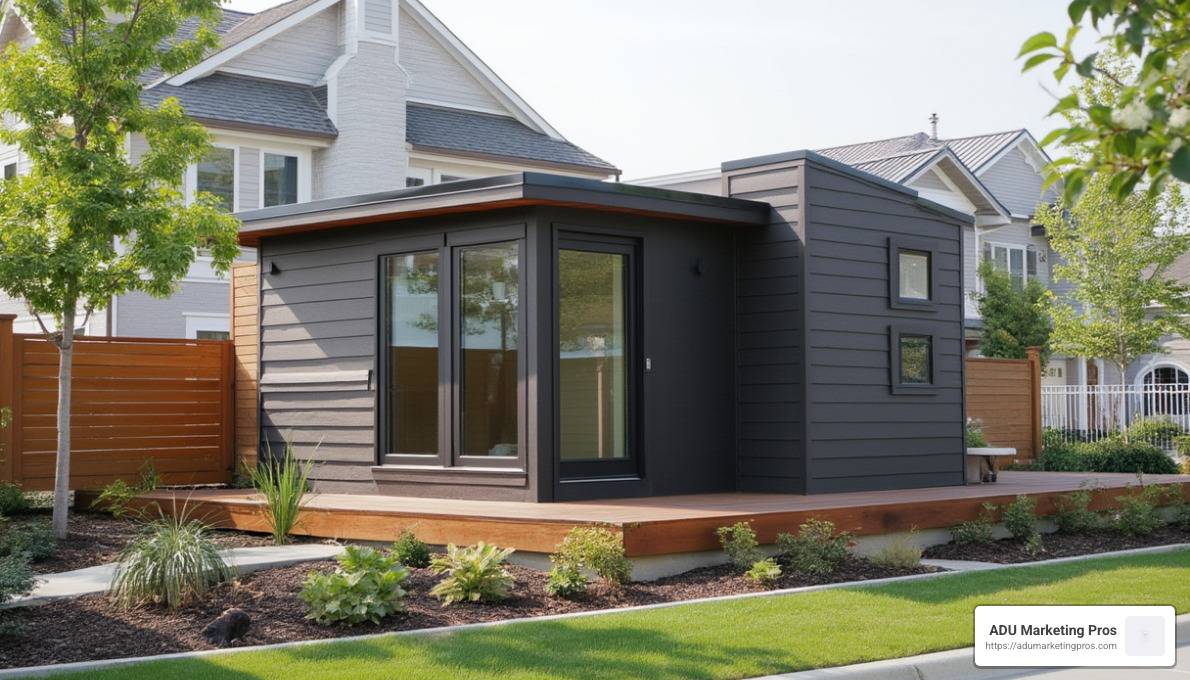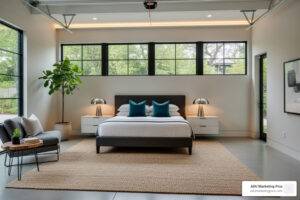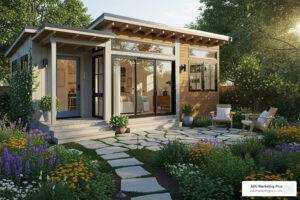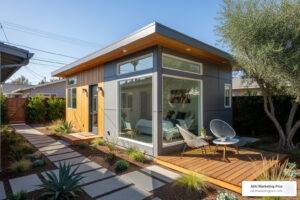Showing Accessory Dwelling Unit Costs: What You Need to Know
Accessory dwelling unit costs can vary significantly, influenced by factors such as type, location, and construction methods. Here’s a quick rundown:
- Detached ADUs: Expect to pay between $120,000 to over $300,000.
- Attached ADUs: Typically range from $100,000 to $250,000.
- Garage Conversions: The most economical option, costing $50,000 to $150,000.
ADUs, also known as granny flats or in-law suites, add a unique and valuable dimension to properties. They offer a versatile way to increase living space or generate rental income. But the path to owning one involves navigating a complex financial journey. Each decision, from selecting the type of ADU to determining its location, can greatly impact costs.
Understanding these variables is crucial, especially in high-cost areas like California, where fees can exceed $200,000. In contrast, regions like Texas offer a more budget-friendly range due to lower construction costs and lenient regulations.
Starting off with clear facts can help you plan your financial journey more effectively. Recognizing the importance of location, project type, and construction methods can pave the way for a successful ADU endeavor. For those looking to dive deeper into the details, stick around as we explore every aspect that affects accessory dwelling unit costs.

Simple guide to Accessory dwelling unit costs:
– 1000 sq ft adu
– ADU cost calculator
Understanding Accessory Dwelling Unit Costs
When planning an ADU, understanding the various cost components is essential. Here’s a breakdown of the key factors that will impact your budget:
Site Preparation
Before construction begins, site preparation is crucial. This includes assessing land conditions, grading, and ensuring accessibility for construction equipment. Costs here can vary widely depending on the terrain and existing infrastructure.
Add-Ons
Add-ons like decks, patios, or additional storage can improve the functionality of your ADU but also increase costs. While these features are optional, they can significantly boost the property’s value and appeal.
Utilities
Connecting utilities is a must for detached ADUs. This involves setting up new water, sewer, and electricity connections, which can be a major expense. In some cases, extending existing lines might be possible, reducing costs.
Building Construction
Construction is the largest expense in an ADU project. It covers materials and labor, with costs influenced by your choice of finishes and the complexity of the design. Site-built ADUs allow for customization but can be pricier, while prefab options offer more cost predictability.
Design and Architecture
Hiring professionals for design and architecture ensures your ADU is functional and aesthetically pleasing. These services come with fees, but they are vital for creating a space that meets both your needs and local building codes.
Permits and Impact Fees
Permits and impact fees are mandatory and vary by location. They ensure compliance with local regulations and can range significantly, especially in areas with strict zoning laws like California. These costs are unavoidable but necessary for legal construction.

By breaking down these costs, you can better plan your financial journey towards ADU ownership. Each element, from site preparation to permits, plays a critical role in determining the overall expense. Understanding these components helps in creating a realistic budget and avoiding unexpected surprises.
Next, we’ll look into the different types of ADUs and how their costs differ. This will further aid in making informed decisions custom to your specific needs and circumstances.
Types of ADUs and Their Cost Implications
When considering Accessory Dwelling Unit costs, it’s important to understand the different types of ADUs available and how each impacts your budget. Here’s a quick rundown:
Detached ADUs
Detached ADUs are standalone structures, separate from the main house. They offer the most privacy but tend to be the most expensive option. This is due to the need for separate utility connections and extensive site work.
- Cost Range: $120,000 to over $300,000.
- Pros: Offers privacy and flexibility. Can be designed to match or complement the primary home.
- Cons: Higher costs due to additional utilities and foundation work.
Attached ADUs
Attached ADUs are built as extensions to the existing home, such as an addition or a converted space like a basement or attic. They are more cost-effective because they often share utilities and structural components with the main house.
- Cost Range: $100,000 to $250,000.
- Pros: Cost savings from shared walls and utilities.
- Cons: Less privacy compared to detached units.
Garage Conversions
Garage conversions are one of the most affordable ways to create an ADU. This involves changing an existing garage into a livable space. Since the structure is already in place, costs are mainly associated with adding necessary utilities and finishes.
- Cost Range: $50,000 to $150,000.
- Pros: Uses existing structures, reducing costs significantly.
- Cons: Limited space and potential need for structural reinforcement.
Prefab ADUs
Prefab ADUs are manufactured offsite and then assembled on your property. They offer predictability in costs and timelines but may have limited customization options.
- Cost Range: $100,000 to $350,000.
- Pros: Faster construction time and cost predictability.
- Cons: Limited design flexibility and potential additional costs for transport and setup.
Site-Built ADUs
Site-built ADUs are constructed from scratch on your property. This method allows for complete customization but can be more expensive and time-consuming.
- Cost Range: $150,000 to $400,000+.
- Pros: Full customization to suit specific needs and preferences.
- Cons: Higher costs and longer construction times compared to prefab options.

Understanding the cost implications of each ADU type is crucial for making informed decisions. Each option has its own set of benefits and drawbacks, and the right choice depends on your budget, property, and personal preferences.
Up next, we’ll explore the factors that influence these costs, such as geographic location and construction methods, to help you plan your ADU project effectively.
Factors Influencing ADU Costs
When planning an ADU project, several key factors can significantly impact your budget. Understanding these elements will help you manage Accessory Dwelling Unit costs more effectively.
Geographic Location
Your location plays a major role in determining ADU costs. In places like California, construction costs are high due to strict regulations and expensive labor. Detached ADUs in California often exceed $300,000. In contrast, Texas offers more affordable options, with prices ranging from $100,000 to $200,000 for similar structures, thanks to fewer regulations and lower labor costs.
Construction Methods
The method you choose for building your ADU greatly affects the cost. Prefab ADUs offer predictable pricing, typically between $100,000 and $350,000, depending on size and finishes. They are built offsite and assembled on your property, reducing labor costs and time.
On the other hand, site-built ADUs allow for complete customization but come with a higher price tag—ranging from $150,000 to over $400,000. These are constructed from scratch on your property and can vary widely in cost based on complexity and location.
Size
Size is another critical factor in ADU costs. Smaller units, like a 500 sq ft ADU, are generally less expensive. In California, these can cost between $150,000 and $250,000, while in Texas, the range might be $100,000 to $150,000. Larger units, such as 1,200 sq ft ADUs, naturally come with higher costs, potentially reaching $350,000+ in California and $300,000 in Texas.
Local Regulations
Local building codes and zoning regulations can also influence costs. Areas with stringent rules may require more expensive materials or additional permits, driving up the overall budget. For example, the Terner Center for Housing Innovation highlights how high-cost areas like California often see ADU projects exceeding $200,000 due to these factors.
Finish Level
The level of finish you choose for your ADU will impact the final cost. High-end finishes and luxury materials will increase expenses significantly. Conversely, opting for basic finishes can help keep costs down. It’s important to balance your preferences with your budget to achieve the desired outcome without overspending.
Understanding these factors will give you a clearer picture of what to expect when budgeting for your ADU project. Up next, we’ll dive into a detailed cost breakdown by ADU type to further guide your planning process.
Cost Breakdown by ADU Type
When exploring Accessory Dwelling Unit costs, understand how different ADU types vary in price. Let’s break down the costs associated with each type, so you know what to expect.
Detached ADU Cost
A detached ADU is a standalone unit, often resembling a small house. This independence makes it one of the pricier options. In California, costs typically range from $150,000 to over $400,000, depending on size, materials, and finishes. These units often require a new foundation, which can add to the expense. However, their separate nature can increase property value and rental potential.
Prefab ADU Cost
Prefab ADUs are built offsite and assembled on your property. This method offers the advantage of predictable pricing, usually between $100,000 and $350,000. While prefab units may limit customization, they save on labor and time, making them an attractive option for many homeowners. Costs can rise due to site preparation and utility connections.
Garage Conversion Cost
Converting an existing garage into an ADU is generally the most cost-effective option. Garage conversions typically range from $50,000 to $150,000. Since the structure already exists, you save on foundation and framing costs. However, adding essentials like plumbing and electrical systems can still be pricey. This option is ideal for those looking to maximize space without a hefty budget.
Cost Per Square Foot
The cost per square foot for an ADU can vary widely. Generally, it falls between $150 and $600 per square foot, influenced by location, materials, and finishes. For example, in the Portland market, costs have ranged from $294 to $327 per square foot. Fixed costs like permits and site preparation can make smaller ADUs disproportionately expensive compared to their size.
Understanding these cost breakdowns helps you make informed decisions when planning your ADU project. Next, we’ll address common questions about ADU costs to further assist your planning process.
Frequently Asked Questions about Accessory Dwelling Unit Costs
Accessory Dwelling Unit Costs per Square Foot
When considering the costs of an Accessory Dwelling Unit, a key measure is the cost per square foot. This can range significantly, from $150 to $600 per square foot. Factors like location, materials, and finishes play a big role in this variation. For instance, a high-end finish in a city like Los Angeles may push costs towards the upper end of this range, while more basic finishes in a less expensive area might stay closer to the lower end.
It’s essential to remember that fixed costs such as permits and site preparation can make smaller ADUs disproportionately expensive relative to their size.
Cheapest Option for an ADU
If you’re on a tight budget, garage conversions tend to be the most economical choice. Since the basic structure is already in place, you avoid the costs associated with building a foundation and exterior walls. Garage conversions typically cost between $50,000 and $150,000. However, keep in mind that adding plumbing and electrical systems can still be costly.
Permits are another consideration; these can vary widely based on local regulations. In California, permit costs can range from $2,000 to $10,000 for building permits and $3,000 to $11,000 for city fees.
How Much Does a 900 Square Foot ADU Cost?
For a 900 square foot ADU, costs can vary based on whether it’s custom-built or modular. Custom-built ADUs offer more flexibility in design but often come with higher costs due to increased labor and material expenses. These can range from $200,000 to $400,000 or more, depending on finishes and site conditions.
On the other hand, modular ADUs, which are prefabricated and assembled on-site, might offer a more budget-friendly option. These typically cost between $100,000 and $350,000, providing a balance between customization and cost efficiency.
Understanding these costs helps you plan your ADU project with a clear financial picture. Next, we’ll explore more about the factors that influence these costs and how to manage them effectively.
Conclusion
When planning an ADU project, understanding the costs involved is crucial. Collaborating with experts like ADU Marketing Pros can make a significant difference in the success of your project. Our expertise in digital marketing for ADU construction and architecture firms helps you stand out in a crowded market. By focusing on expertise over price, we ensure that your ADU business attracts high-quality leads and grows revenue.
A professional site survey is an essential first step in any ADU project. It provides valuable insights into property specifics, helping you create a realistic project scope and budget. This step ensures that unexpected costs are minimized and that your project proceeds smoothly.
Platforms like Dwellito are also valuable resources. They allow you to compare ADU providers nationwide, offering a clear view of costs and options without needing a significant upfront investment. This transparency helps homeowners approach their ADU projects with financial clarity, custom to their specific needs and goals.
Understanding the market is key to successful ADU projects. By staying informed about local regulations, construction methods, and cost implications, you can make informed decisions that improve the feasibility and success of your ADU investment.
For more insights into ADU marketing solutions, visit our ADU Marketing Solutions page. Here, you’ll find how our custom strategies can help your firm thrive in the competitive ADU market.




